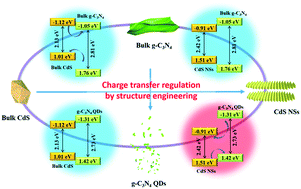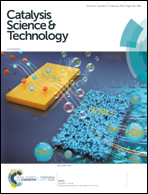Nanoporous 2D semiconductors encapsulated by quantum-sized graphitic carbon nitride: tuning directional photoinduced charge transfer via nano-architecture modulation†
Abstract
Recent years have witnessed a tremendous upsurge in constructing multifunctional heterostructured photocatalysts by capitalizing on the semiconductor building blocks of varying dimensionalities in terms of their synergistic superior charge separation/transfer efficiency. Nevertheless, tunable modulation of charge transfer via structure engineering still constitutes a challenge. Herein, zero-dimensional single-layered graphitic-carbon nitride (C3N4) quantum dots (g-C3N4 QDs) and two-dimensional (2D) nanoporous CdS nanosheets (NSs) were utilized as assembly units for strategically constructing well-defined g-C3N4 QDs/CdS NS heterostructures via a facile and green electrostatic self-assembly approach, by which g-C3N4 QDs were uniformly and intimately tethered on the CdS NSs framework. Intriguingly, such g-C3N4 QDs/CdS NS heterostructures demonstrate an unconventional charge transfer pathway owing to the unique energy level structure of g-C3N4 QDs and CdS NSs dictated by structure engineering. It was significant to unveil that the g-C3N4 QDs/CdS NS heterostructure exhibits versatile and remarkably boosted photoredox performances toward anaerobic reduction of aromatic nitro compounds and mineralization of organic pollutants along with prominent photo-corrosion resistance under visible light irradiation in comparison with single and various bulk counterparts. The underlying reasons accounting for the considerably improved photoredox performances of g-C3N4 QDs/CdS NS heterostructures were uncovered including boosted charge separation/transfer afforded by peculiar structural merits of C3N4 QDs and 2D CdS NSs, intimate interfacial contact and a unique spatial interfacial integration mode. Furthermore, predominant active species in the photoredox reactions were systematically explored and unambiguously determined, based on which, a photocatalytic mechanism was presented. It is hoped that our work could spur further interest in rationally designing diverse heterostructured photocatalysts and simultaneously provide new insights into the spatial charge transfer in multifarious photoredox catalysis for substantial solar energy conversion.



 Please wait while we load your content...
Please wait while we load your content...